Yihui Wang
Distilled Prompt Learning for Incomplete Multimodal Survival Prediction
Mar 03, 2025Abstract:The integration of multimodal data including pathology images and gene profiles is widely applied in precise survival prediction. Despite recent advances in multimodal survival models, collecting complete modalities for multimodal fusion still poses a significant challenge, hindering their application in clinical settings. Current approaches tackling incomplete modalities often fall short, as they typically compensate for only a limited part of the knowledge of missing modalities. To address this issue, we propose a Distilled Prompt Learning framework (DisPro) to utilize the strong robustness of Large Language Models (LLMs) to missing modalities, which employs two-stage prompting for compensation of comprehensive information for missing modalities. In the first stage, Unimodal Prompting (UniPro) distills the knowledge distribution of each modality, preparing for supplementing modality-specific knowledge of the missing modality in the subsequent stage. In the second stage, Multimodal Prompting (MultiPro) leverages available modalities as prompts for LLMs to infer the missing modality, which provides modality-common information. Simultaneously, the unimodal knowledge acquired in the first stage is injected into multimodal inference to compensate for the modality-specific knowledge of the missing modality. Extensive experiments covering various missing scenarios demonstrated the superiority of the proposed method. The code is available at https://github.com/Innse/DisPro.
ConceptCLIP: Towards Trustworthy Medical AI via Concept-Enhanced Contrastive Langauge-Image Pre-training
Jan 26, 2025Abstract:Trustworthiness is essential for the precise and interpretable application of artificial intelligence (AI) in medical imaging. Traditionally, precision and interpretability have been addressed as separate tasks, namely medical image analysis and explainable AI, each developing its own models independently. In this study, for the first time, we investigate the development of a unified medical vision-language pre-training model that can achieve both accurate analysis and interpretable understanding of medical images across various modalities. To build the model, we construct MedConcept-23M, a large-scale dataset comprising 23 million medical image-text pairs extracted from 6.2 million scientific articles, enriched with concepts from the Unified Medical Language System (UMLS). Based on MedConcept-23M, we introduce ConceptCLIP, a medical AI model utilizing concept-enhanced contrastive language-image pre-training. The pre-training of ConceptCLIP involves two primary components: image-text alignment learning (IT-Align) and patch-concept alignment learning (PC-Align). This dual alignment strategy enhances the model's capability to associate specific image regions with relevant concepts, thereby improving both the precision of analysis and the interpretability of the AI system. We conducted extensive experiments on 5 diverse types of medical image analysis tasks, spanning 51 subtasks across 10 image modalities, with the broadest range of downstream tasks. The results demonstrate the effectiveness of the proposed vision-language pre-training model. Further explainability analysis across 6 modalities reveals that ConceptCLIP achieves superior performance, underscoring its robust ability to advance explainable AI in medical imaging. These findings highlight ConceptCLIP's capability in promoting trustworthy AI in the field of medicine.
Towards A Generalizable Pathology Foundation Model via Unified Knowledge Distillation
Jul 26, 2024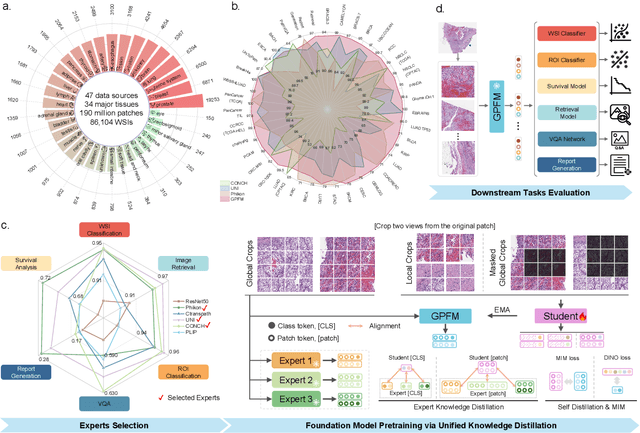

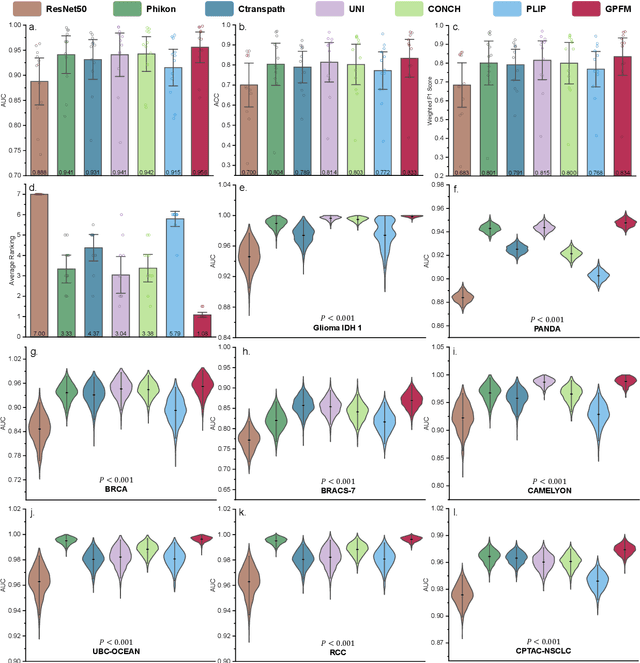
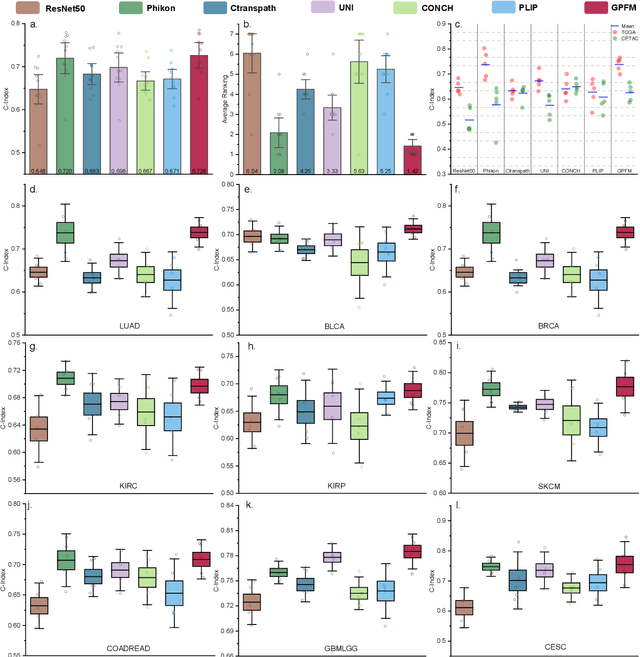
Abstract:Foundation models pretrained on large-scale datasets are revolutionizing the field of computational pathology (CPath). The generalization ability of foundation models is crucial for the success in various downstream clinical tasks. However, current foundation models have only been evaluated on a limited type and number of tasks, leaving their generalization ability and overall performance unclear. To address this gap, we established a most comprehensive benchmark to evaluate the performance of off-the-shelf foundation models across six distinct clinical task types, encompassing a total of 39 specific tasks. Our findings reveal that existing foundation models excel at certain task types but struggle to effectively handle the full breadth of clinical tasks. To improve the generalization of pathology foundation models, we propose a unified knowledge distillation framework consisting of both expert and self knowledge distillation, where the former allows the model to learn from the knowledge of multiple expert models, while the latter leverages self-distillation to enable image representation learning via local-global alignment. Based on this framework, a Generalizable Pathology Foundation Model (GPFM) is pretrained on a large-scale dataset consisting of 190 million images from around 86,000 public H\&E whole slides across 34 major tissue types. Evaluated on the established benchmark, GPFM achieves an impressive average rank of 1.36, with 29 tasks ranked 1st, while the the second-best model, UNI, attains an average rank of 2.96, with only 4 tasks ranked 1st. The superior generalization of GPFM demonstrates its exceptional modeling capabilities across a wide range of clinical tasks, positioning it as a new cornerstone for feature representation in CPath.
A Multimodal Knowledge-enhanced Whole-slide Pathology Foundation Model
Jul 22, 2024
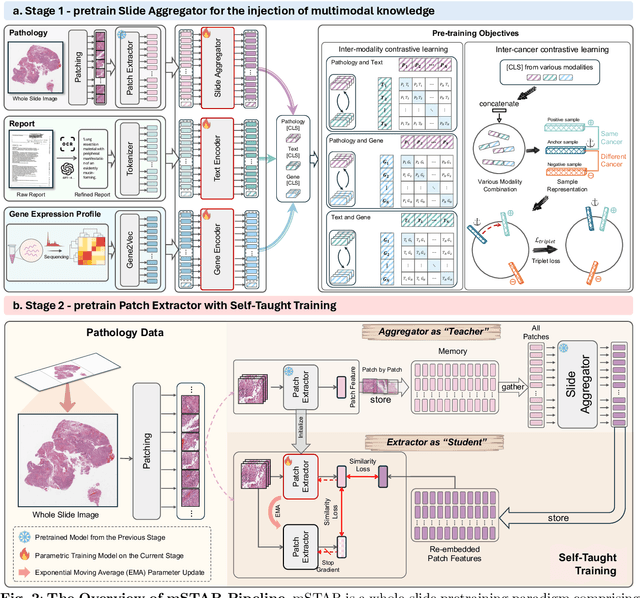
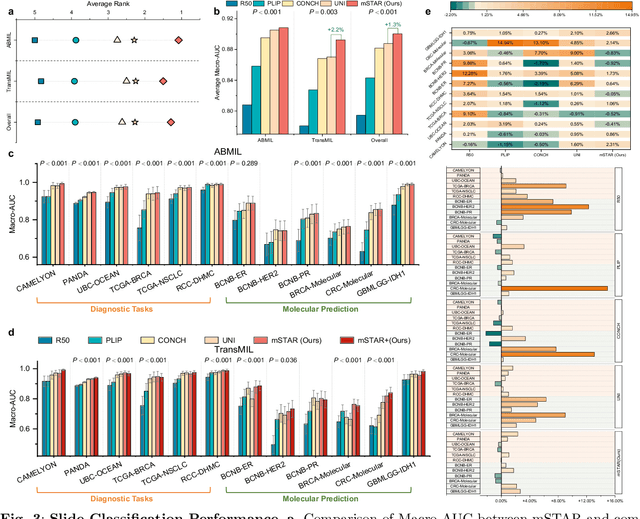

Abstract:Remarkable strides in computational pathology have been made in the task-agnostic foundation model that advances the performance of a wide array of downstream clinical tasks. Despite the promising performance, there are still several challenges. First, prior works have resorted to either vision-only or vision-captions data, disregarding invaluable pathology reports and gene expression profiles which respectively offer distinct knowledge for versatile clinical applications. Second, the current progress in pathology FMs predominantly concentrates on the patch level, where the restricted context of patch-level pretraining fails to capture whole-slide patterns. Here we curated the largest multimodal dataset consisting of H\&E diagnostic whole slide images and their associated pathology reports and RNA-Seq data, resulting in 26,169 slide-level modality pairs from 10,275 patients across 32 cancer types. To leverage these data for CPath, we propose a novel whole-slide pretraining paradigm which injects multimodal knowledge at the whole-slide context into the pathology FM, called Multimodal Self-TAught PRetraining (mSTAR). The proposed paradigm revolutionizes the workflow of pretraining for CPath, which enables the pathology FM to acquire the whole-slide context. To our knowledge, this is the first attempt to incorporate multimodal knowledge at the slide level for enhancing pathology FMs, expanding the modelling context from unimodal to multimodal knowledge and from patch-level to slide-level. To systematically evaluate the capabilities of mSTAR, extensive experiments including slide-level unimodal and multimodal applications, are conducted across 7 diverse types of tasks on 43 subtasks, resulting in the largest spectrum of downstream tasks. The average performance in various slide-level applications consistently demonstrates significant performance enhancements for mSTAR compared to SOTA FMs.
A Survey on Vision Mamba: Models, Applications and Challenges
Apr 29, 2024Abstract:Mamba, a recent selective structured state space model, performs excellently on long sequence modeling tasks. Mamba mitigates the modeling constraints of convolutional neural networks and offers advanced modeling capabilities similar to those of Transformers, through global receptive fields and dynamic weighting. Crucially, it achieves this without incurring the quadratic computational complexity typically associated with Transformers. Due to its advantages over the former two mainstream foundation models, Mamba exhibits great potential to be a visual foundation model. Researchers are actively applying Mamba to various computer vision tasks, leading to numerous emerging works. To help keep pace with the rapid advancements in computer vision, this paper aims to provide a comprehensive review of visual Mamba approaches. This paper begins by delineating the formulation of the original Mamba model. Subsequently, our review of visual Mamba delves into several representative backbone networks to elucidate the core insights of the visual Mamba. We then categorize related works using different modalities, including image, video, point cloud, multi-modal, and others. Specifically, for image applications, we further organize them into distinct tasks to facilitate a more structured discussion. Finally, we discuss the challenges and future research directions for visual Mamba, providing insights for future research in this quickly evolving area. A comprehensive list of visual Mamba models reviewed in this work is available at https://github.com/Ruixxxx/Awesome-Vision-Mamba-Models.
MambaMIL: Enhancing Long Sequence Modeling with Sequence Reordering in Computational Pathology
Mar 11, 2024Abstract:Multiple Instance Learning (MIL) has emerged as a dominant paradigm to extract discriminative feature representations within Whole Slide Images (WSIs) in computational pathology. Despite driving notable progress, existing MIL approaches suffer from limitations in facilitating comprehensive and efficient interactions among instances, as well as challenges related to time-consuming computations and overfitting. In this paper, we incorporate the Selective Scan Space State Sequential Model (Mamba) in Multiple Instance Learning (MIL) for long sequence modeling with linear complexity, termed as MambaMIL. By inheriting the capability of vanilla Mamba, MambaMIL demonstrates the ability to comprehensively understand and perceive long sequences of instances. Furthermore, we propose the Sequence Reordering Mamba (SR-Mamba) aware of the order and distribution of instances, which exploits the inherent valuable information embedded within the long sequences. With the SR-Mamba as the core component, MambaMIL can effectively capture more discriminative features and mitigate the challenges associated with overfitting and high computational overhead. Extensive experiments on two public challenging tasks across nine diverse datasets demonstrate that our proposed framework performs favorably against state-of-the-art MIL methods. The code is released at https://github.com/isyangshu/MambaMIL.
HistGen: Histopathology Report Generation via Local-Global Feature Encoding and Cross-modal Context Interaction
Mar 08, 2024Abstract:Histopathology serves as the gold standard in cancer diagnosis, with clinical reports being vital in interpreting and understanding this process, guiding cancer treatment and patient care. The automation of histopathology report generation with deep learning stands to significantly enhance clinical efficiency and lessen the labor-intensive, time-consuming burden on pathologists in report writing. In pursuit of this advancement, we introduce HistGen, a multiple instance learning-empowered framework for histopathology report generation together with the first benchmark dataset for evaluation. Inspired by diagnostic and report-writing workflows, HistGen features two delicately designed modules, aiming to boost report generation by aligning whole slide images (WSIs) and diagnostic reports from local and global granularity. To achieve this, a local-global hierarchical encoder is developed for efficient visual feature aggregation from a region-to-slide perspective. Meanwhile, a cross-modal context module is proposed to explicitly facilitate alignment and interaction between distinct modalities, effectively bridging the gap between the extensive visual sequences of WSIs and corresponding highly summarized reports. Experimental results on WSI report generation show the proposed model outperforms state-of-the-art (SOTA) models by a large margin. Moreover, the results of fine-tuning our model on cancer subtyping and survival analysis tasks further demonstrate superior performance compared to SOTA methods, showcasing strong transfer learning capability. Dataset, model weights, and source code are available in https://github.com/dddavid4real/HistGen.
 Add to Chrome
Add to Chrome Add to Firefox
Add to Firefox Add to Edge
Add to Edge